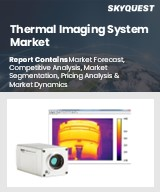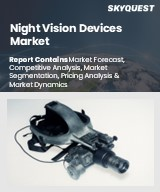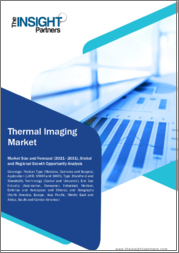
|
시장보고서
상품코드
1776846
세계의 군용 서멀 이미징 시장 : 플랫폼별, 검출기 유형별, 파장 대역별, 지역별, 기회, 예측(2018-2032년)Global Military Thermal Imaging Market Assessment, By Platform [Handheld Units, Weapon-Mounted Systems, Vehicle/Aircraft Platforms], By Detector Type [Cooled, Uncooled], By Waveband [MWIR, LWIR], By Region, Opportunities and Forecast, 2018-2032F |
||||||
세계의 군용 서멀 이미징 시장 규모는 2025-2032년의 예측 기간 중 5.95%의 CAGR로 확대하며, 2024년 73억 4,000만 달러에서 2032년에는 116억 5,000만 달러로 성장할 것으로 예측됩니다. 전 세계 군용 서멀 이미징 기술의 급속한 발전은 육상, 공중, 해상에서 운용되는 첨단 감시 시스템에 대한 니즈 증가에 기인합니다. 서멀라이밍 장비는 시야가 좋지 않은 상황에서의 국경 보안, 표적 포착, 야간 작전에 필수적인 작전 능력을 제공합니다.
현대의 기술 발전으로 소형-경량-비냉각의 서멀라이징 장비가 개발되어 드론 및 군용 시스템에 적용이 가능해졌습니다. 인공지능과 머신러닝 알고리즘을 접목하여 이미지를 처리하고 목표를 감지하는 능력이 향상되고 있습니다. 국방 분야의 현대화 노력과 국제 분쟁의 격화가 채택 확대를 촉진하고 있습니다. 주요 기업은 연구개발에 많은 자원을 투입하여 군적 요구사항을 충족하는 신기술을 개발하고 있습니다. 동시에, 더 작고 저렴한 장비에 대한 수요는 전 세계 방위 조직 전체에서 그 사용을 확대하고 있습니다.
예를 들어 2024년 11월 Theon International Plc.는 나이트비전 제품 판매와 IRIS 서멀 클립온 시스템 출시에 성공하여 5,000만 달러의 신규 계약을 체결하고 소프트 백로그를 확대했습니다. 이는 군용 서멀라이징 장비 기술의 새로운 성능 기준과 함께 고객의 관심이 높아지고 있음을 보여줍니다.
세계의 군용 서멀 이미징 시장에 대해 조사했으며, 시장의 개요와 플랫폼별, 검출기 유형별, 파장 대역별, 지역별 동향 및 시장에 참여하는 기업의 개요 등을 제공하고 있습니다.
목차
제1장 프로젝트 범위와 정의
제2장 조사 방법
제3장 미국 관세의 영향
제4장 개요
제5장 고객의 소리
제6장 세계의 군용 서멀 이미징 시장 전망, 2018-2032년
- 시장 규모 분석과 예측
- 시장 점유율 분석과 예측
- 플랫폼별
- 핸드헬드 유닛
- 무기 탑재 시스템
- 차량/항공기 플랫폼
- 검출기 유형별
- 냉각
- 비냉각
- 파장 대역별
- MWIR(3-5μm)
- 원적외선(8-12μm)
- 지역별
- 북미
- 유럽
- 아시아태평양
- 남미
- 중동 및 아프리카
- 기업별 시장 점유율 분석(상위 5사 및 기타 - 금액별, 2024년)
- 플랫폼별
- 2024년 시장 맵 분석
제7장 북미의 군용 서멀 이미징 시장 전망, 2018-2032년
- 시장 규모 분석과 예측
- 시장 점유율 분석과 예측
- 국가별 시장 평가
- 미국
- 캐나다
- 멕시코
제8장 유럽의 군용 서멀 이미징 시장 전망, 2018-2032년
- 독일
- 프랑스
- 이탈리아
- 영국
- 러시아
- 네덜란드
- 스페인
- 튀르키예
- 폴란드
제9장 아시아태평양의 군용 서멀 이미징 시장 전망, 2018-2032년
- 인도
- 중국
- 일본
- 호주
- 베트남
- 한국
- 인도네시아
- 필리핀
제10장 남미의 군용 서멀 이미징 시장 전망, 2018-2032년
- 브라질
- 아르헨티나
제11장 중동 및 아프리카의 군용 서멀 이미징 시장 전망, 2018-2032년
- 사우디아라비아
- 아랍에미리트
- 남아프리카공화국
제12장 Porter's Five Forces 분석
제13장 PESTLE 분석
제14장 시장 역학
- 시장 촉진요인
- 시장이 해결해야 할 과제
제15장 시장 동향과 발전
제16장 사례 연구
제17장 경쟁 구도
- 시장 리더 TOP 5의 경쟁 매트릭스
- 참여 기업 TOP 5의 SWOT 분석
- TOP 10 시장 기업의 주요 기업 상황
- RTX Corporation
- Lockheed Martin Corporation
- Leonardo S.p.A.
- Thales Group S.A.
- L3Harris Technologies, Inc.
- Teledyne FLIR LLC
- BAE Systems Plc
- Elbit Systems Ltd.
- Northrop Grumman Corporation
- Opgal Optronic Industries Ltd.
제18장 전략적 제안
제19장 조사회사 소개·면책사항
KSA 25.07.31Global military thermal imaging market is projected to witness a CAGR of 5.95% during the forecast period 2025-2032, growing from USD 7.34 billion in 2024 to USD 11.65 billion in 2032. Rapid advancements in global military thermal imaging technology are driven by the growing need for sophisticated surveillance systems that operate on land, in the air, and at sea. Thermal imaging equipment provides vital operational capabilities during reduced visibility situations, enabling border protection, target acquisition, and nighttime operations.
Modern technological advancements have enabled the development of compact, lightweight, and uncooled thermal imagers, which now support applications in drone and soldier systems. The incorporation of artificial intelligence together with machine learning algorithms enhances the ability to process images and detect targets. Defense sector modernization efforts, together with growing international conflicts, are driving increased adoption. Leading companies dedicate resources to research and development to create new technologies that fulfill military requirements. At the same time, trends toward smaller and more affordable devices expand their use throughout worldwide defense organizations.
For instance, in November 2024, Theon International Plc. obtained USD 50 Million in fresh contracts and expanded its soft backlog through successful night vision product sales and IRIS thermal clip-on system launches. This indicates growing customer interest, together with new performance benchmarks in military thermal imaging technology.
Technological Advancement Pumps the Military Thermal Imaging Market Growth
Technological advancements in the military thermal imaging industry are driving substantial market expansion. The performance and versatility of thermal imaging systems improve due to advancements in sensor resolution, miniaturization, and energy efficiency enhancements. Improved thermal imaging systems enable military operations in surveillance, target acquisition, and reconnaissance missions across land, air, and naval domains. Operational capabilities increase through the integration of thermal imaging technology into unmanned systems and AI-based analytics. The growing demand for border protection and counterterrorism operations drives increased market demand. Military forces require advanced thermal imaging systems for operational success in different operational environments because they pursue modernization strategies.
For instance, in October 2024, PCO, S.A. entered a contract with Poland's 4th Regional Logistics Base to supply KLW-1R Asteria cooled thermal cameras, which enhance the operational capabilities of Rosomak APCs. The cameras utilize high-resolution detectors that align with global military thermal imaging market trends, emphasizing advanced night vision and targeting capabilities.
Border Security Fuels the Global Military Thermal Imaging Market Growth
The market for military thermal imaging is expanding steadily due to rising international security concerns regarding borders and defense systems. Modernization efforts by defense organizations and governments to upgrade their surveillance systems have caused a rapid increase in thermal imaging system requirements. The systems deliver essential low-visibility operation and night-time surveillance capabilities that have become crucial elements in current border patrol operations. Defense organizations allocate their budgets toward thermal imaging solutions due to growing geopolitical tensions and asymmetric security threats. Manufacturers now develop small-sized thermal imaging systems that deliver high-resolution images and rugged construction for use in harsh operational environments. The market is expected to grow at a higher rate as defense organizations continue to modernize their operations.
For instance, in April 2025, the U.S. Navy awarded LightPath Technologies a USD 2.2 million contract to supply its G5 Infrared advanced IR cameras, which enhance military thermal imaging functions necessary for border protection and defense operations. The mounting security requirements have triggered increased investment and rising demand for thermal imaging technology.
Aircraft Platforms Dominates the Military Thermal Imaging Market Share
The military thermal imaging market maintains its leadership position through aircraft platforms, as these systems provide advanced system integration and address the rising operational needs for improved battlefield awareness. These platforms operate from elevated positions to conduct broad surveillance, including target identification and tracking in various environmental conditions. Thermal imaging systems are experiencing a growing demand for installation in manned and unmanned aerial vehicles due to the advancement of precision strike technology and the need for real-time intelligence. The implementation of infrared technology on aircraft platforms significantly improves military mission success rates throughout various defense operations. Military forces worldwide are incorporating aircraft-based systems as essential components of their thermal imaging approaches, driven by ongoing modernization efforts.
For instance, in September 2024, LightPath Technologies received an order valued at USD 3.5 million to deliver Germanium-free infrared optics used in the F-35. This demonstrates the critical role of high-performance aircraft platforms in generating demand for the military thermal imaging market, and repeated orders confirm robust industry validation.
North America Dominates the Military Thermal Imaging Market Size
The global military thermal imaging market holds its most significant market share in North America, primarily due to substantial defense budgets, advanced military facilities, and ongoing investments in advanced surveillance technologies. The region maintains a stronghold because major defense contractors are based there, and thermal imaging systems are extensively used by land, air, and naval military units. These systems gain increased adoption through strategic measures that aim to improve modern military capabilities while providing better battlefield visibility. Regional development receives continuous support from government initiatives and technological breakthroughs. Military-grade thermal imaging capabilities continue to evolve in North America due to increasing interest in border security operations and tactical applications.
For instance, in May 2024, Obsidian Sensors Inc. developed a technology that reduces thermal imaging costs and enhances resolution quality, revolutionizing the industry. The United States maintains its leadership position in military thermal imaging due to advancements in technology and substantial defense requirements in North America.
Impact of U.S. Tariffs on the Global Military Thermal Imaging Market
The implementation of tariffs throughout the United States causes imported parts such as semiconductors and optics to become more expensive, which makes military thermal imagers costlier for defense budget requirements.
The implementation of tariffs leads to the postponement of specialized sensor component delivery, which causes supply chain interruptions and delays the delivery of essential military thermal imaging equipment to defense forces.
The combination of elevated prices and supply chain obstacles could lead to slower market expansion because defense sectors that focus on prices might postpone or decrease their acquisition of advanced thermal imaging technology.
The financial burden of tariffs affects smaller manufacturers more strongly than larger defense contractors, who can either obtain components domestically or build their facilities, thus changing the market competition.
Key Players Landscape and Outlook
Military thermal imaging market growth remains strong because advanced surveillance and reconnaissance systems have increased demand. The leading players invest their resources in optimizing sensor performance while working to minimize device dimensions and implement AI for immediate threat identification. Technological advancements in cooled and uncooled imaging systems now enable extended operational capabilities across various military platforms, including land-based vehicles, aircraft, and naval vessels. The increased defense spending, together with worldwide modernization programs, drives faster market adoption. Thermal imaging technology, now integrated into unmanned systems and soldier-wearable gear, provides revolutionary capabilities for military battlefield surveillance. The evolving market environment is a result of these combined developments, which drive both long-term technological progress and global deployment through continuous research activities and strategic partnerships.
For instance, in November 2024, the U.S. Army selected Red Cat's Black Widow drone, which features Teledyne FLIR LLC's thermal imaging and AI software, to serve its Short-Range Reconnaissance Program. The military utilizes advanced thermal imaging technology, combined with AI, for its operations, which occur in both daytime and nighttime conditions.
Table of Contents
1. Project Scope and Definitions
2. Research Methodology
3. Impact of U.S. Tariffs
4. Executive Summary
5. Voice of Customers
- 5.1. Respondent Demographics
- 5.2. Brand Awareness
- 5.3. Factors Considered in Purchase Decisions
- 5.4. Lifecycle Cost Efficiency
- 5.5. Resolution Efficiency
6. Global Military Thermal Imaging Market Outlook, 2018-2032F
- 6.1. Market Size Analysis & Forecast
- 6.1.1. By Value
- 6.2. Market Share Analysis & Forecast
- 6.2.1. By Platform
- 6.2.1.1. Handheld Units
- 6.2.1.2. Weapon-Mounted Systems
- 6.2.1.3. Vehicle/Aircraft Platforms
- 6.2.2. By Detector Type
- 6.2.2.1. Cooled
- 6.2.2.2. Uncooled
- 6.2.3. By Waveband
- 6.2.3.1. MWIR (3-5 μm)
- 6.2.3.2. LWIR (8-12 μm)
- 6.2.4. By Region
- 6.2.4.1. North America
- 6.2.4.2. Europe
- 6.2.4.3. Asia-Pacific
- 6.2.4.4. South America
- 6.2.4.5. Middle East and Africa
- 6.2.5. By Company Market Share Analysis (Top 5 Companies and Others - By Value, 2024)
- 6.2.1. By Platform
- 6.3. Market Map Analysis, 2024
- 6.3.1. By Platform
- 6.3.2. By Detector Type
- 6.3.3. By Waveband
- 6.3.4. By Region
7. North America Military Thermal Imaging Market Outlook, 2018-2032F
- 7.1. Market Size Analysis & Forecast
- 7.1.1. By Value
- 7.2. Market Share Analysis & Forecast
- 7.2.1. By Platform
- 7.2.1.1. Handheld Units
- 7.2.1.2. Weapon-Mounted Systems
- 7.2.1.3. Vehicle/Aircraft Platforms
- 7.2.2. By Detector Type
- 7.2.2.1. Cooled
- 7.2.2.2. Uncooled
- 7.2.3. By Waveband
- 7.2.3.1. MWIR (3-5 μm)
- 7.2.3.2. LWIR (8-12 μm)
- 7.2.4. By Country Share
- 7.2.4.1. United States
- 7.2.4.2. Canada
- 7.2.4.3. Mexico
- 7.2.1. By Platform
- 7.3. Country Market Assessment
- 7.3.1. United States Military Thermal Imaging Market Outlook, 2018-2032F*
- 7.3.1.1. Market Size Analysis & Forecast
- 7.3.1.1.1. By Value
- 7.3.1.2. Market Share Analysis & Forecast
- 7.3.1.2.1. By Platform
- 7.3.1.2.1.1. Handheld Units
- 7.3.1.2.1.2. Weapon-Mounted Systems
- 7.3.1.2.1.3. Vehicle/Aircraft Platforms
- 7.3.1.2.2. By Detector Type
- 7.3.1.2.2.1. Cooled
- 7.3.1.2.2.2. Uncooled
- 7.3.1.2.3. By Waveband
- 7.3.1.2.3.1. MWIR (3-5 μm)
- 7.3.1.2.3.2. LWIR (8-12 μm)
- 7.3.1.2.1. By Platform
- 7.3.1.1. Market Size Analysis & Forecast
- 7.3.2. Canada
- 7.3.3. Mexico
- 7.3.1. United States Military Thermal Imaging Market Outlook, 2018-2032F*
All segments will be provided for all regions and countries covered
8. Europe Military Thermal Imaging Market Outlook, 2018-2032F
- 8.1. Germany
- 8.2. France
- 8.3. Italy
- 8.4. United Kingdom
- 8.5. Russia
- 8.6. Netherlands
- 8.7. Spain
- 8.8. Turkey
- 8.9. Poland
9. Asia-Pacific Military Thermal Imaging Market Outlook, 2018-2032F
- 9.1. India
- 9.2. China
- 9.3. Japan
- 9.4. Australia
- 9.5. Vietnam
- 9.6. South Korea
- 9.7. Indonesia
- 9.8. Philippines
10. South America Military Thermal Imaging Market Outlook, 2018-2032F
- 10.1. Brazil
- 10.2. Argentina
11. Middle East and Africa Military Thermal Imaging Market Outlook, 2018-2032F
- 11.1. Saudi Arabia
- 11.2. UAE
- 11.3. South Africa
12. Porter's Five Forces Analysis
13. PESTLE Analysis
14. Market Dynamics
- 14.1. Market Drivers
- 14.2. Market Challenges
15. Market Trends and Developments
16. Case Studies
17. Competitive Landscape
- 17.1. Competition Matrix of Top 5 Market Leaders
- 17.2. SWOT Analysis for Top 5 Players
- 17.3. Key Players Landscape for Top 10 Market Players
- 17.3.1. RTX Corporation
- 17.3.1.1. Company Details
- 17.3.1.2. Key Management Personnel
- 17.3.1.3. Key Products Offered
- 17.3.1.4. Key Financials (As Reported)
- 17.3.1.5. Key Market Focus and Geographical Presence
- 17.3.1.6. Recent Developments/Collaborations/Partnerships/Mergers and Acquisitions
- 17.3.2. Lockheed Martin Corporation
- 17.3.3. Leonardo S.p.A.
- 17.3.4. Thales Group S.A.
- 17.3.5. L3Harris Technologies, Inc.
- 17.3.6. Teledyne FLIR LLC
- 17.3.7. BAE Systems Plc
- 17.3.8. Elbit Systems Ltd.
- 17.3.9. Northrop Grumman Corporation
- 17.3.10. Opgal Optronic Industries Ltd.
- 17.3.1. RTX Corporation
Companies mentioned above DO NOT hold any order as per market share and can be changed as per information available during research work.



















